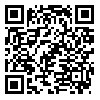دوره 4، شماره 3 - ( 5-1397 )
جلد 4 شماره 3 صفحات 138-131 |
برگشت به فهرست نسخه ها
Download citation:
BibTeX | RIS | EndNote | Medlars | ProCite | Reference Manager | RefWorks
Send citation to:



BibTeX | RIS | EndNote | Medlars | ProCite | Reference Manager | RefWorks
Send citation to:
Husni Amireh M M, Omer F E A M. Caregivers’ Perspective About the Levels of Sensory Processing Problems in Children With Autism. JCCNC 2018; 4 (3) :131-138
URL: http://jccnc.iums.ac.ir/article-1-183-fa.html
URL: http://jccnc.iums.ac.ir/article-1-183-fa.html
Caregivers’ Perspective About the Levels of Sensory Processing Problems in Children With Autism. نشریه مراقبت پرستاری مددجو محور. 1397; 4 (3) :131-138
چکیده: (3712 مشاهده)
Background: Children with autism should interact and get along with their surrounding environment. Therefore, the researchers must try to explain the reasons of challenges in their adaptive behaviors. This study aimed to evaluate levels of challenges in sensory processing and the motor domain of adaptive behavior among children with autism in Egypt, and to explore the effect of sensory processing on subdomains of gross and fine motor skills.
Methods: This is a cross-sectional study. Study questionnaires were distributed to 180 caregivers of children with autism in Cairo, Egypt, between July 2017 and February 2018. The caregivers were selected by convenience sampling method. The questionnaires used were the sensory checklist and adaptive behavior scales. Descriptive statistics and comparing means were used to determine the levels of sensory processing and motor domain of adaptive behavior. Linear regression analyses was used to test the effects of sensory domains on motor areas. SPSS-PC V. 25 was used to analyze the obtained data.
Results: The results demonstrated various problems in children’s sensory processing and the motor domain of adaptive behavior. Caregivers reported that 96.67% of the children had frequent sensory challenges in at least one component of sensory domains, mostly in visual system (27.2%). Subdomain of fine motor skills (Mean=1.4951) showed higher challenges than gross motor skills (Mean=1.9455). This study proved significant inverse effect for movement processing on gross motor subdomain at α=0.05.
Conclusion: Parents of children with autism, occupational therapists, and other healthcare practitioners should gain in-depth knowledge regarding their children’s behaviors and their possible reasons.
Methods: This is a cross-sectional study. Study questionnaires were distributed to 180 caregivers of children with autism in Cairo, Egypt, between July 2017 and February 2018. The caregivers were selected by convenience sampling method. The questionnaires used were the sensory checklist and adaptive behavior scales. Descriptive statistics and comparing means were used to determine the levels of sensory processing and motor domain of adaptive behavior. Linear regression analyses was used to test the effects of sensory domains on motor areas. SPSS-PC V. 25 was used to analyze the obtained data.
Results: The results demonstrated various problems in children’s sensory processing and the motor domain of adaptive behavior. Caregivers reported that 96.67% of the children had frequent sensory challenges in at least one component of sensory domains, mostly in visual system (27.2%). Subdomain of fine motor skills (Mean=1.4951) showed higher challenges than gross motor skills (Mean=1.9455). This study proved significant inverse effect for movement processing on gross motor subdomain at α=0.05.
Conclusion: Parents of children with autism, occupational therapists, and other healthcare practitioners should gain in-depth knowledge regarding their children’s behaviors and their possible reasons.
فهرست منابع
1. Abd El Samee, A. E., 2016. Adaptive behavior scales. Cairo: Arab Corporation for Psychological Tests.
2. American Psychiatric Association., 2011. Diagnostic and stical manual of mental disorders. Washington: American Psychiatric Association Publishing.
3. Baker, A. E., Lane, A., Angley, M. T. & Young, R. L., 2008. The relationship between sensory processing patterns and behavioural responsiveness in autistic disorder: A pilot study. Journal of Autism and Developmental Disorders, 38(5), pp. 867-75. [DOI:10.1007/s10803-007-0459-0] [PMID] [DOI:10.1007/s10803-007-0459-0]
4. Byrne, M. W., 2009. Sensory processing disorder: Any of a nurse practitioner's business. Journal of the American Academy of Nurse Practitioners, 21(6), pp. 314-21. [DOI:10.1111/j.1745-7599.2009.00417.x] [PMID] [DOI:10.1111/j.1745-7599.2009.00417.x]
5. Dawson, G. & Watling, R., 2000. Interventions to facilitate auditory, visual, and motor integration in autism: A review of the evidence. Journal of Autism and Developmental Disorders, 30(5), pp. 415-21. [DOI:10.1023/A:1005547422749] [DOI:10.1023/A:1005547422749]
6. Gabriels, R.L., et al., 2005. Repetitive behaviors in autism: Relationships with associated clinical features. Research in Developmental Disabilities, 26(2), pp. 169-81. [DOI:10.1016/j.ridd.2004.05.003] [PMID] [DOI:10.1016/j.ridd.2004.05.003]
7. Jasmin, E., et al., 2009. Sensori-motor and daily living skills of preschool children with autism spectrum disorders. Journal of Autism and Developmental Disorders, 39(2), pp. 231-41.[DOI:10.1007/s10803-008-0617-z] [PMID] [DOI:10.1007/s10803-008-0617-z]
8. Lane, A. E., et al., 2010. Sensory processing subtypes in autism: Association with adaptive behavior. Journal of Autism and Developmental Disorders, 40(1), pp. 112-22. [DOI:10.1007/s10803-009-0840-2] [PMID] [DOI:10.1007/s10803-009-0840-2]
9. Larkey, S., 2007. Practical Sensory Programmes: For Students with Autism Spectrum Disorder and Other Special Needs. London: Jessica Kingsley Publishers.
10. Miller, L. & Lane, S. J., 2000. Toward a consensus in terminology in sensory integration theory and practice: Part 1: Taxonomy of neurophysiological processes. Sensory Integration Special Interest Section Quarterly, 23(1), pp. 1-4.
11. Nieto, C., Lopez, B. & Gandia, H., 2017. Relationships between atypical sensory processing patterns, maladaptive behaviour and maternal stress in Spanish children with autism spectrum disorder. Journal of Intellectual Disability Research, 61(12), pp. 1140-50. [DOI:10.1111/jir.12435] [PMID] [DOI:10.1111/jir.12435]
12. O'Donnell, S., et al., 2012. Sensory processing, problem behavior, adaptive behavior, and cognition in preschool children with autism spectrum disorders. American Journal of Occupational Therapy, 66(5), pp. 586-94. [DOI:10.5014/ajot.2012.004168] [PMID] [DOI:10.5014/ajot.2012.004168]
13. Sparrow, S. S., Cicchetti, D. V. & Saulnier, C. A., 2016. Vineland Adaptive Behavior Scales, 3rd Edition (Vineland-3). London: Pearson.
| بازنشر اطلاعات | |
 |
این مقاله تحت شرایط Creative Commons Attribution-NonCommercial 4.0 International License قابل بازنشر است. |




